
Dials & Symbols
of the French revolution
Compiled by: Fred Kats
The Republican Calendar and Decimal time

Table of contents:
Appendix.
Calendar
& time.
Decimal
time history.
Dials.
Republican <-> Gregorian
conversion.
The
Metric System
Names
of the days of the Republican year.
Symbols
explained.
Sources
& further reading.
 SYMBOLS EXPLAINED.
SYMBOLS EXPLAINED.
carmagnole

(click for more)
La Carmagnole (click
here for song text
and melody)

(click to enlarge)
 La Carmagnole. La Carmagnole.
A popular however rather filthy song and dance against the imprisoned
Royal Family.
Eye

Eye
 Eye. Eye.
Vigilance, essence
and divine knowledge.
clasped hands

Clasped hands.
(click to enlarge)
 Clasped hands (les mains serrées).
Clasped hands (les mains serrées).
It appears on (Comtoise) clocks during the early 'royal' period of the revolution and
during the 'restoration' (1814-1830) to express the (re)union of the
people and their King.
(symbole de l'union de trois ordres puis de peuple et de son Roi. Ref.
René Schopping) It is also believed to be a symbol of fraternity.
The Phrygian cap,
Le bonnet Phrygien





Mithras
(click pictures for more)

The troyan
Paris with Phrygian cap.
(click picture for more)
 The Phrygian Cap (Liberty cap) The Phrygian Cap (Liberty cap)
The 1789 Revolutionaries adopted a cap worn by ancient Persian soldiers
and the inhabitants of Phrygia, as they saw it as a symbol of liberation
i.e. being freed and purified of evil.
The cap was a symbol of the Persian (initially Indian) deity
Mithras. The cult of Mithras spread
widely in the empire of Alexandre the Great and reached Rome through the Phrygians of Asia Minor (Turkey)
in the 1st century BC.
The Phrygians wore a high woolen cap, normally falling over the right
side of the head. It was their custom to have newly freed slaves
officially wear it and this made them citizens in their own right. It was also adopted by freed slaves in Roman times.
The first Phrygian caps appeared on the heads of the French people a few
months after the storming of the Bastille. They were made out of red
woolen cloth and went with the striped clothes of the most fervent
revolutionaries, the sans-culottes. Wearing the red cap was a way of
publicly displaying one's patriotism.
This cap was one of the star features of the historic day of 20th June
1792, when the common people surged into the Tuileries. In the angry
crowd, which managed to reach the king himself, a municipal guard called
Mouchet held out a Phrygian cap, on the end of a pike, to the monarch. The
astounded descendant of Saint Louis did not know how to react. He grasped
it and put it on his head. This gesture somewhat appeased the hostility of
the assailants.
triangle

Triangle with plumb line
 Triangle with plumb line. Triangle with plumb line.
The perfect accord and balance.
fasces


Fasces.
 Fasces: Fasces:
A set of rods bound in the form of a bundle
which
contained an axe. The word fasces means "bundle" and refers to the fact that it is a
bundle of rods, which surrounded an ax in the middle. In ancient Rome, the lictors carried fasces before consul, praetors and dictators, i.e.,
magistrates that held imperium (which means that they had the right to
command and interpret the flight of the birds).
Fasces surmounted by a Phrygian cap. Power to the
liberated people.
Note: Fasces has also been the symbol of Italian fascist in the 20th
century.
eagle

Eagle Consulaire 1799-1804

Imperial Eagle 1804-1814
 Eagles 'Consulaire' and
'Imperial' Eagles 'Consulaire' and
'Imperial'
In Greek mythology the Eagle was attributed to Zeus (Jupiter)
rooster

Rooster (cockerel): Vigilance.
 The Gallic Rooster. (Le Coq Gaulois) The Gallic Rooster. (Le Coq Gaulois)
One of the national emblems of France, the Coq Gaulois (the Gallic
Rooster) decorated French flags during the Revolution. It is the symbol of
the French people because of the play on words of the Latin gallus meaning
Gaul and gallus meaning 'coq', or rooster.
Caesar called, what was later France, Gallia (Gaul), most likely because
the rebellious Celts used a rooster as symbol in their escutcheon.
The rooster has been used as an ornament on church bell towers in France
since the early Middle Ages, but at that time it was probably used to
symbolize vigilance as roosters are known to crow at the expectation of
the sunrise. The Gallic Rooster has been used for centuries by folk
artists as a decorative motif on ceramics or carved and veneered wooden
furniture.
The rooster played an important role as the revolutionary symbol, but it
would become an official emblem under the July Monarchy and the Second
Republic when it was seen on the pole of regiments' flags. In 1830, the
"Gallic Rooster" replaced the fleur-de-lis as the national emblem, and it
was again discarded by Napoleon III.
Since 1848, the rooster have been seen on the seal of the Republic (Liberty
is seated on a rudder decorated by a rooster); it was used from 1899 as a
motif on gold 20 franc coins and it occasionally appears on stamps.
The rooster is the emblem of (sponsored) French sports teams in international
competitions.
star

Star, pentagram.
(click to enlarge)
 Star.
Star.
Restoration (1814-1824)
 APPENDIX
APPENDIX 1) French table of symbols
Le Coq
La Crosse d'Evéque
L'Epée
La Béche
Le Râteau
La Gerbe de Blé
La Fleur de Lys
La Couronne
Deux L entrelacés
La Cocarde Tricolore
La Cocarde Noire
La Cocarde Blanche
La Bastille
L'Arbre
Le Chéne
La Pique
La Jeune Femme au Miroir
Le Drapeau
Le Faisceau
Les Lauriers
Le Triangle
L'Oeil
Le Canon
Le Bonnet Phrygien
La Carmagnole
La Guillotine
Le Lion
La France
La Cornemuse
La Chaîne Brisée
La Corne
La Renommée
L'Ancre
Le Globe
La Ruche
La Palme
|
La Vigilance
Le Clergé
La Noblesse
Le Tiers-Stat
Le Tiers-Etat
L'Abondance,
La Prospérité
La Monarchie
La Monarchie
La Monarchie
L'Emblème des Patriotes
L'Emblème de la Reine
L'Emblème des Royalistes
Le Symbole de la Victoire
du Peuple sur la Tyrannie
La Liberté
Les Vertus Civiques
Le Peuple
La Vérité
La Nation
L'Union, la Fraternité
La Victoire
L'Accord Parfait
La Vigilance
La Force des Armées
Le Symbole de la Liberté
Chanson et Danse populaires
La Justice Révolutionnaire
La Force
La Patrie
La Paix
L'Abolition de l'Esclavage
L'Abondance de la Nature
L'Annonciatrice
L'Espérance
L'Universalité
Le Peuple Laborieux
La Victoire des Armées |
| |
|
 Sources and further reading:
Sources and further reading:
1) Les Heures
Revolutionnaires.
Yves Droz et Joseph Flores
Edité par l'Afaha.
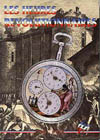
2) Cadrans de la Révolution, 1789-1800
Watch dials of the French Revolution,
Zifferblätter der französischen Revolution,
Roberto Panicali.
Publisher: Scriptar Lausanne 1972
ISBN: B0000E810O
3)
Decimal
time history.
by:
John D. Hynes.
4) More on the
ADOPTION of the new calendar.
As to the New Calendar, we may say here rather than elsewhere that
speculative men have long been struck with the inequalities and
incongruities of the Old Calendar; that a New one has long been as good
as determined on. Marechal the Atheist, almost ten years ago, proposed a
New Calendar, free at least from superstition: this the Paris
Municipality would now adopt, in defect of a better; at all events, let
us have either this of Marechal`s or a better,--the New Era being come.
Petitions, more than once, have been sent to that effect; and indeed,
for a year past, all Public Bodies, Journalists, and Patriots in
general, have dated First Year of the Republic. It is a subject not
without difficulties. But the Convention has taken it up; and Romme, as
we say, has been meditating it; not Marechal`s New Calendar, but a
better New one of Romme`s and our own. Romme, aided by a Monge, a
Lagrange and others, furnishes mathematics; Fabre d`Eglantine furnishes
poetic nomenclature: and so, on the 5th of October 1793, after trouble
enough, they bring forth this New Republican Calendar of theirs, in a
complete state; and by Law, get it put in action.
(back
to context)
Source:
The French
Revolution A History.
By Thomas Carlyle. |
 TABLE OF SYMBOLS
TABLE OF SYMBOLS
Anchor - Hope
Bagpipe - Peace
Bastille - Emblem of the people conquering tyranny
Bishop's cross - Clergy
Broken chain- Abolishment of slavery
Canon - The power of the army
Carmagnole - Popular republican song and dance
Clasped hands - Fraternity
Corn (horn of plenty) - Nature's abundance
Corn sheaf - Abundance, Prosperity
Crown - Monarchy
Eye - Vigilance
Fame - Announcer
Fasces - Unity, Brotherhood, Power.
1)
Flag - The Nation
Fleur de Lys - Monarchy
France - The country (patriotic)
Globe - Universality
Guillotine - Revolutionary justice
Hive - The working class
Laurel (wreath) - Victory
Lion - Power
Oak - Civil virtue
Palm (branch) - Victory of the armies.
Phrygian cap - Symbol of liberty
Pique - The people
Rake - The third estate or commonalty
Rooster (cockerel) - Vigilance
Rosette tri-colour - Emblem of the patriots
Rosette black - Emblem of the Queen
Rosette white - Emblem of the Royalists
Scale - Justice
Spade - The third estate or commonalty
Star
- used during the restoration period
Sword - Nobility
Tree - Liberty
Triangle - The perfect accord
Two enlaced 'L's - Emblem of the Monarchy
Young woman with mirror - Truth
 The Metric System
The Metric System
One of the main contributions of the French Revolution
was the adoption of the metric system. An
attempt to decimalize all aspects of daily life (calendar, measurements,
currency, etc.)
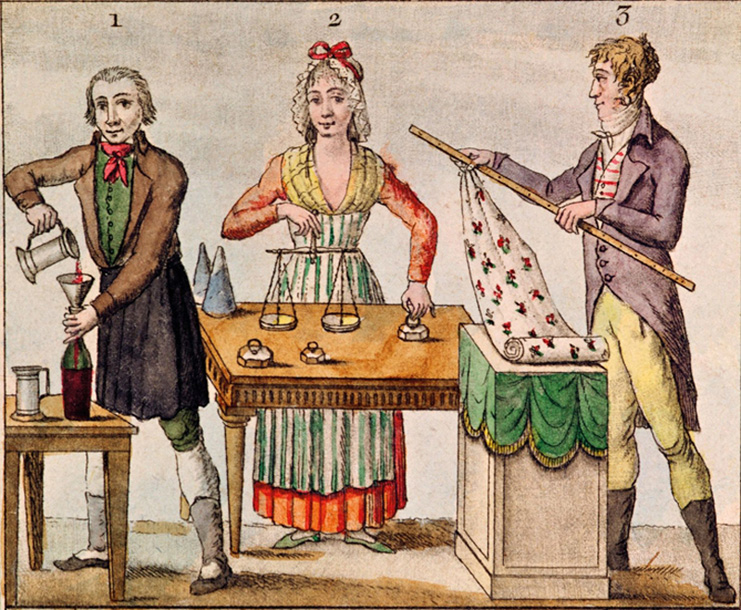 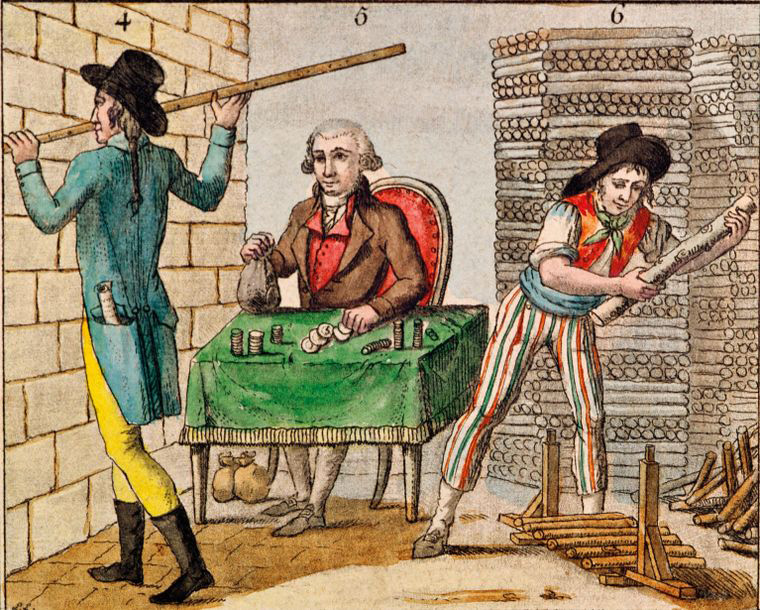
As elsewhere in Europe, France’s old weights and
measures originated from a system used by the Romans, which had evolved
into a multitude of local variations. Enlightenment scholars were faced
with the task of reforming a jumble of 800 different units of measurement,
ranging from the toise to the lieue, including the
quart and the pinte.
Some of these units were quite
extravagant: in early 18th-century Bordeaux, a unit of land was defined by
the distance a man’s voice could carry! It was better to have a loud voice
if you wanted to be a landowner.
There was little to no
standardization: in Paris, for example, a pinte equaled 0.93
liters, while in Saint-Denis it was 1.46 liters. An aune, used to
measure fabric, was based on the width of local looms and varied greatly.
This chaotic system was prone to fraud and stifled both domestic and
international trade.
Courtesy: Jaz le Bon Temps
 The Republican Calendar and
Decimal time
The Republican Calendar and
Decimal time
Decimal or Revolutionary time was adopted by decree
of the National Convention in 1793. It
stipulated that the Gregorian calendar should be abandoned and replaced by
the
Republican calendar which divided the day into ten hours each with
one hundred minutes and then further sub-divided into one hundred seconds.
Although perhaps a logical 'simplification' of timekeeping the habits of the
populous were difficult to change. The new system meant having to design a
new dial and to this end a competition was organized to invent one that was
clear and easy to read.
Despite the efforts of some of
the great horological minds the system was never really adopted and
clockmakers had no real reason to fully support it because their
Revolutionary clocks were useless outside France which ruined their export
trade.
By art. 22, April 7, 1795 it was no longer compulsory to use Decimal time and even before then
clocks and watches were being made with both the 'old' and 'new' systems as
on the example below.
Finally it was decreed that the Decimal system had proved impossible to
implement properly and from January 1, 1806 French timekeeping reverted back
to the traditional system.
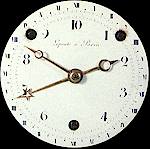
(click to enlarge)
October 5th 1793:
Adoption by the
'Convention du Calendrier Révolutionnaire de
Gilbert Romme et
Philippe Fabre d' Eglantine' An important day for horology because of being the
starting point of decimal clocks and watches and the 30 days calendar. (more
on the adoption)
April 7th 1795 (art.22*):
Suspension of the obligation to use the 'decimal time'
*Art. 22. La disposition de la loi du 4 frimaire an 2, qui rend
obligatoire l'usage de la division décimale du jour et de ses parties,
est suspendue indéfiniment.
The use of the Republican calendar practically ends the 1st
of January 1806.
 CALENDAR
& TIME CALENDAR
& TIME
The republican year commences the 22nd of september and ends the 21st of
september.
The years were numbered as follows:
|
Year
II
III
IV
V
VI
VII
VIII
IX
X
XI
XII
XIII
XIV
XV |
Starts 22
sept:
1793
1794
1795
1796
1797
1798
1799
1800
1801
1802
1803
1804
1805
1806 |
The year is divided in 12 equal months of 30 days each,
plus 5 or 6 days called 'sans-culottides'
(the days of the poor) which were renamed, after august
24 1794, 'complementary days'. (jours complémentaires)
They were treated as Holidays, or Festival days and were named:
|
1
2
3
4
5
6 |
Jour de la Vertu (Virtue),
Jour de Genie (Genius),
Jour de Travail (Work),
Jour de la Raison (Reason),
Jour de la Recompense (Reward)
Jour de la Revolution (Revolution). |
The names of the months are:
|
Autum:
Winter:
Spring:
Summer: |
Vendémiaire
Brumaire
Frimaire
Nivôse
Pluviôse
Ventôse
Germinal
Floréal
Prairial
Messidor
Thermidor
Fructidor |
Vintage
Fog
Frost
Snow
Rain
Wind
Germ
Flowers
Meadow
Harvest
Heat
Fruit |
Each month was divided in three equal
parts of 10 days named:
|
first second third
|
decade
decade
decade |
The names of the days of the decades were:
|
|
Primidi
Duodi
Tridi
Quartidi
Quintidi
Sextidi
Septidi
Octidi
Nonidi
Décadi |
Each day was divided in:
10 hours of 100 minutes.
A multiple of ten decimal minutes was often called a 'décime', i.e.
one-tenth of a decimal hour.
It was also conveniently close to a
traditional quarter-hour.

DIALS
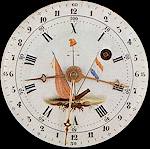
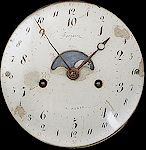
Combined traditional & decimal dial
(click to enlarge)
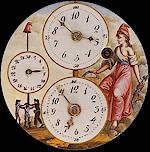
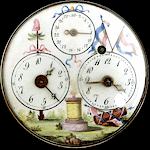
Combined traditional & decimal dial with republican date.
(click to enlarge)
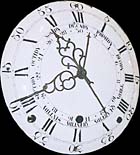
Combined traditional & decimal dial showing republican days of the week
and month.
(click to enlarge)
 APPENDIX
APPENDIX
2)
Republican <->
Gregorian calendar conversion.
Type 'Ctrl + F' to find any word or number.
Click
here for a printable pdf version of this table.
| Republican
|
|
Gregorian |
|
|
|
|
|
|
Vendémaire |
1 |
I |
22 |
Sept. 1792 |
| Brumaire |
2 |
|
22 |
October |
| Frimaire |
3 |
|
21 |
November |
| Nivôse |
4 |
|
21 |
December |
| Pluviôse |
5 |
1793 |
20 |
January |
| Ventôse |
6 |
|
19 |
February |
| Germinal |
7 |
|
21 |
March |
| Floréal |
8 |
|
20 |
April |
| Prairial |
9 |
|
20 |
May |
| Messidor |
10 |
|
19 |
June |
| Thermidor |
11 |
|
19 |
July |
| Fructidor |
12 |
|
18 |
August |
|
Vendémaire |
1 |
II |
22 |
September |
| Brumaire |
2 |
|
22 |
October |
| Frimaire |
3 |
|
22 |
November |
| Nivôse |
4 |
|
21 |
December |
| Pluviôse |
5 |
1794 |
20 |
January |
| Ventôse |
6 |
|
19 |
February |
| Germinal |
7 |
|
21 |
March |
| Floréal |
8 |
|
20 |
April |
| Prairial |
9 |
|
20 |
May |
| Messidor |
10 |
|
19 |
June |
| Thermidor |
11 |
|
19 |
July |
| Fructidor |
12 |
|
18 |
August |
|
Vendémaire |
1 |
III |
22 |
September |
| Brumaire |
2 |
|
22 |
October |
| Frimaire |
3 |
|
22 |
November |
| Nivôse |
4 |
|
21 |
December |
| Pluviôse |
5 |
1795 |
20 |
January |
| Ventôse |
6 |
|
19 |
February |
| Germinal |
7 |
|
21 |
March |
| Floréal |
8 |
|
20 |
April |
| Prairial |
9 |
|
20 |
May |
| Messidor |
10 |
|
19 |
June |
| Thermidor |
11 |
|
19 |
July |
| Fructidor |
12 |
|
18 |
August |
|
Vendémaire |
1 |
IV |
23 |
September |
| Brumaire |
2 |
|
23 |
October |
| Frimaire |
3 |
|
22 |
November |
| Nivôse |
4 |
|
22 |
December |
| Pluviôse |
5 |
1796 |
21 |
January |
| Ventôse |
6 |
|
20 |
February |
| Germinal |
7 |
|
21 |
March |
| Floréal |
8 |
|
20 |
April |
| Prairial |
9 |
|
20 |
May |
| Messidor |
10 |
|
19 |
June |
| Thermidor |
11 |
|
19 |
July |
| Fructidor |
12 |
|
18 |
August |
|
Vendémaire |
1 |
V |
22 |
September |
| Brumaire |
2 |
|
22 |
October |
| Frimaire |
3 |
|
22 |
November |
| Nivôse |
4 |
|
21 |
December |
| Pluviôse |
5 |
1797 |
20 |
January |
| Ventôse |
6 |
|
19 |
February |
| Germinal |
7 |
|
21 |
March |
| Floréal |
8 |
|
20 |
April |
| Prairial |
9 |
|
20 |
May |
| Messidor |
10 |
|
19 |
June |
| Thermidor |
11 |
|
19 |
July |
| Fructidor |
12 |
|
18 |
August |
|
Vendémaire |
1 |
VI |
22 |
September |
| Brumaire |
2 |
|
22 |
October |
| Frimaire |
3 |
|
22 |
November |
| Nivôse |
4 |
|
21 |
December |
| Pluviôse |
5 |
1798 |
20 |
January |
| Ventôse |
6 |
|
19 |
February |
| Germinal |
7 |
|
21 |
March |
| Floréal |
8 |
|
20 |
April |
| Prairial |
9 |
|
20 |
May |
| Messidor |
10 |
|
19 |
June |
| Thermidor |
11 |
|
19 |
July |
| Fructidor |
12 |
|
18 |
August |
|
Vendémaire |
1 |
VII |
22 |
September |
| Brumaire |
2 |
|
22 |
October |
| Frimaire |
3 |
|
22 |
November |
| Nivôse |
4 |
|
21 |
December |
| Pluviôse |
5 |
1799 |
20 |
January |
| Ventôse |
6 |
|
19 |
February |
| Germinal |
7 |
|
21 |
March |
| Floréal |
8 |
|
20 |
April |
| Prairial |
9 |
|
20 |
May |
| Messidor |
10 |
|
19 |
June |
| Thermidor |
11 |
|
19 |
July |
| Fructidor |
12 |
|
18 |
August |
|
Vendémaire |
1 |
VIII |
23 |
September |
| Brumaire |
2 |
|
23 |
October |
| Frimaire |
3 |
|
22 |
November |
| Nivôse |
4 |
|
22 |
December |
| Pluviôse |
5 |
1800 |
21 |
January |
| Ventôse |
6 |
|
20 |
February |
| Germinal |
7 |
|
22 |
March |
| Floréal |
8 |
|
21 |
April |
| Prairial |
9 |
|
21 |
May |
| Messidor |
10 |
|
20 |
June |
| Thermidor |
11 |
|
20 |
July |
| Fructidor |
12 |
|
19 |
August |
|
Vendémaire |
1 |
IX |
23 |
September |
| Brumaire |
2 |
|
23 |
October |
| Frimaire |
3 |
|
22 |
November |
| Nivôse |
4 |
|
22 |
December |
| Pluviôse |
5 |
1801 |
21 |
January |
| Ventôse |
6 |
|
20 |
February |
| Germinal |
7 |
|
22 |
March |
| Floréal |
8 |
|
21 |
April |
| Prairial |
9 |
|
21 |
May |
| Messidor |
10 |
|
20 |
June |
| Thermidor |
11 |
|
20 |
July |
| Fructidor |
12 |
|
19 |
August |
|
Vendémaire |
1 |
X |
23 |
September |
| Brumaire |
2 |
|
23 |
October |
| Frimaire |
3 |
|
22 |
November |
| Nivôse |
4 |
|
22 |
December |
| Pluviôse |
5 |
1802 |
21 |
January |
| Ventôse |
6 |
|
20 |
February |
| Germinal |
7 |
|
22 |
March |
| Floréal |
8 |
|
21 |
April |
| Prairial |
9 |
|
21 |
May |
| Messidor |
10 |
|
20 |
June |
| Thermidor |
11 |
|
20 |
July |
| Fructidor |
12 |
|
19 |
August |
|
Vendémaire |
1 |
XI |
23 |
September |
| Brumaire |
2 |
|
23 |
October |
| Frimaire |
3 |
|
22 |
November |
| Nivôse |
4 |
|
22 |
December |
| Pluviôse |
5 |
1803 |
21 |
January |
| Ventôse |
6 |
|
20 |
February |
| Germinal |
7 |
|
22 |
March |
| Floréal |
8 |
|
21 |
April |
| Prairial |
9 |
|
21 |
May |
| Messidor |
10 |
|
20 |
June |
| Thermidor |
11 |
|
20 |
July |
| Fructidor |
12 |
|
19 |
August |
|
Vendémaire |
1 |
XII |
24 |
September |
| Brumaire |
2 |
|
24 |
October |
| Frimaire |
3 |
|
23 |
November |
| Nivôse |
4 |
|
23 |
December |
| Pluviôse |
5 |
1804 |
22 |
January |
| Ventôse |
6 |
|
21 |
February |
| Germinal |
7 |
|
22 |
March |
| Floréal |
8 |
|
21 |
April |
| Prairial |
9 |
|
21 |
May |
| Messidor |
10 |
|
20 |
June |
| Thermidor |
11 |
|
20 |
July |
| Fructidor |
12 |
|
19 |
August |
|
Vendémaire |
1 |
XIII |
23 |
September |
| Brumaire |
2 |
|
23 |
October |
| Frimaire |
3 |
|
22 |
November |
| Nivôse |
4 |
|
22 |
December |
| Pluviôse |
5 |
1805 |
21 |
January |
| Ventôse |
6 |
|
20 |
February |
| Germinal |
7 |
|
22 |
March |
| Floréal |
8 |
|
21 |
April |
| Prairial |
9 |
|
21 |
May |
| Messidor |
10 |
|
20 |
June |
| Thermidor |
11 |
|
20 |
July |
| Fructidor |
12 |
|
19 |
August |
|
Vendémaire |
1 |
XIV |
23 |
September |
| Brumaire |
2 |
|
23 |
October |
| Frimaire |
3 |
|
22 |
November |
| Nivôse |
4 |
|
22 |
December |
| Pluviôse |
5 |
1806 |
21 |
January |
| Ventôse |
6 |
|
20 |
February |
| Germinal |
7 |
|
22 |
March |
| Floréal |
8 |
|
21 |
April |
| Prairial |
9 |
|
21 |
May |
| Messidor |
10 |
|
20 |
June |
| Thermidor |
11 |
|
20 |
July |
| Fructidor |
12 |
|
19 |
August |
|
Vendémaire |
1 |
XV |
23 |
September |
|
Brumaire |
2 |
|
|
October |
|
Frimaire |
3 |
|
|
November |
|
Nivôse |
4 |
|
|
December |
|
Pluviôse |
5 |
1807 |
|
January |
|
Ventôse |
6 |
|
|
February |
|
Germinal |
7 |
|
|
March |
|
Floréal |
8 |
|
|
April |
|
Prairial |
9 |
|
|
May |
|
Messidor |
10 |
|
|
June |
|
Thermidor |
11 |
|
|
July |
|
Fructidor |
12 |
|
|
August |
|
Vendémaire |
1 |
XVI |
|
September |
|
Brumaire |
2 |
|
|
October |
|
Frimaire |
3 |
|
|
November |
|
Nivôse |
4 |
|
|
December |

|

























